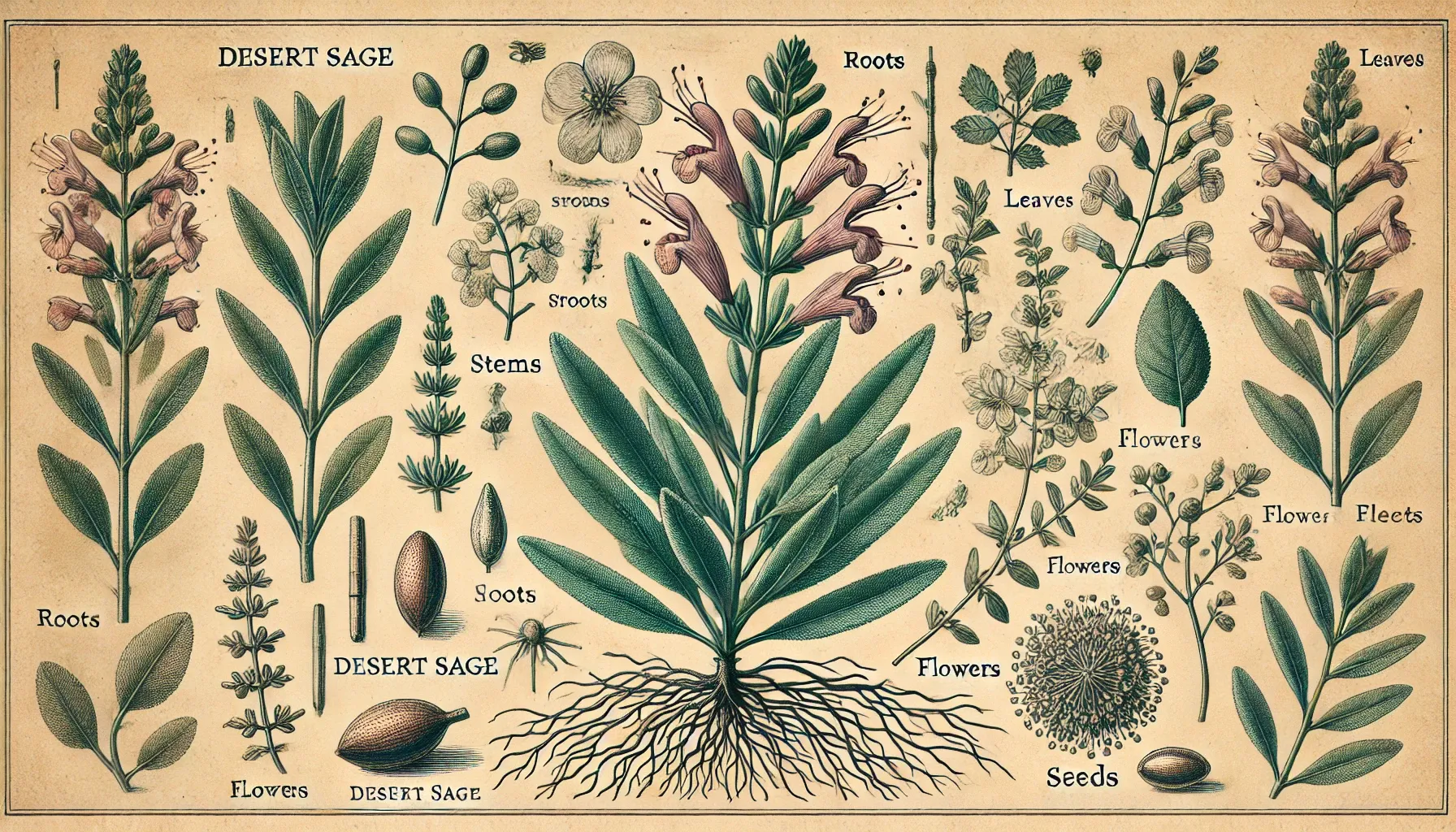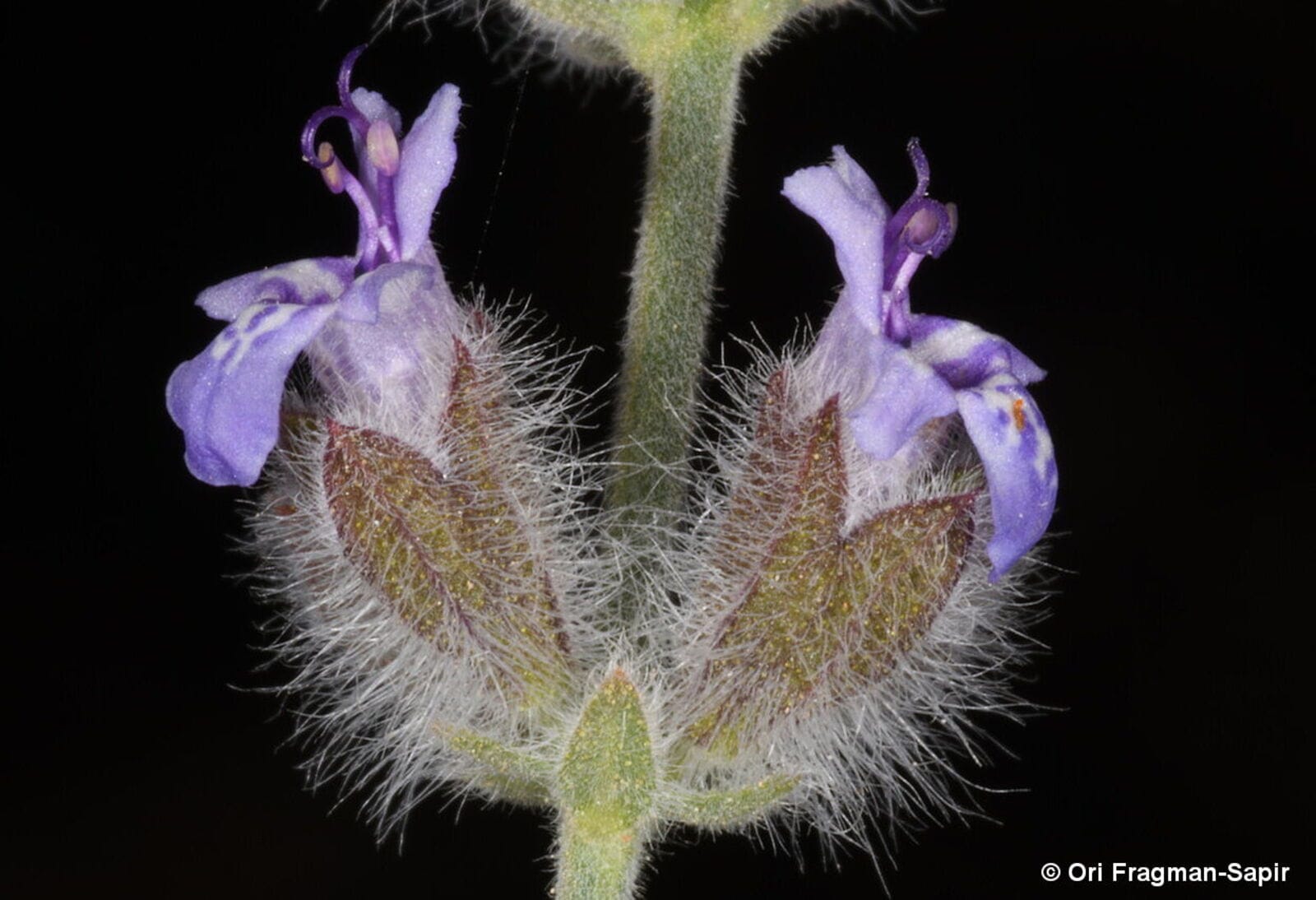Desert Sage (Salvia deserti)
Salvia deserti, also known as desert sage, is traditionally used by Bedouins to treat respiratory ailments, digestive issues and as an antiseptic. This resilient plant plays a crucial role in desert ecosystems and cultural heritage.

| Botanical name | Salvia deserti |
| Arabic name | مرمرية / مريميّة |
| Family | Lamiaceae |
| Native to | Palestine, Saudi Arabia, Sinai |
| Conservation status | Nearly threatened |
| Medicinal part | Aerial parts |
| Energetics | Dry and Warm / Bitter and astringent |
| Organ Affinity | Digestive system, reproductive system, respiratory system, skin |
The Latin root of Salvia is salvere, which means to save, to heal. The arabic name for sage is مريميّة (Maramiyeh) or sometimes مرمرية (Marmariyeh), or El Salmyah السالميه, which is common in the golf states, and El Qusaan القصعين in the North Arabic countries.
In the Sinai Peninsula, several species of sage (Salvia) can be found. Some of the notable species include:
Salvia deserti: Commonly known as desert sage, it is well-adapted to the arid conditions of the Sinai region.
Salvia aegyptiaca: Known as Egyptian sage, this species is native to desert regions in Egypt and the Middle East.
Salvia fruticosa: Also known as Greek sage or three-lobed sage, it is found in Mediterranean regions, including parts of the Sinai.
Salvia lanigera: This species, characterized by its woolly leaves, is also found in arid and semi-arid regions, including Sinai.
Salvia spinosa: Known for its spiny appearance, it is adapted to dry habitats and can be found in the Sinai Peninsula.
These species are adapted to the harsh, arid environment of Sinai, exhibiting various drought-resistant features such as small, hairy leaves and deep root systems.
Table of contents
BOTANICAL FEATURES
Morphology
Salvia deserti is a perennial herb that grows in a shrubby form. It is well-adapted to arid environments.The plant typically reaches heights of 30 to 60 cm (12 to 24 inches).
Leaves
The leaves are generally narrow, lanceolate to ovate, and measure about 2 to 5 cm in length.They are covered with fine hairs, giving them a somewhat silvery or grayish appearance.Leaves are opposite, meaning they grow in pairs on either side of the stem.
Flowers
The flowers are arranged in terminal spikes or racemes, which can be up to 10 cm long, they are typically blue or violet, though the exact shade can vary.
Their shape is tubular with two lips, characteristic of the Lamiaceae family.
Salvia deserti usually blooms in the spring and early summer.
Stem
The stems are square in cross-section, another characteristic feature of the botanical family, they may be slightly woody at the base and are also covered with fine hairs.
Fruit
The fruit is a schizocarp, which splits into four nutlets when mature.Each nutlet is small, about 2 to 3 mm long.
Habitat and Adaptations
Salvia deserti is adapted to desert environments, typically found in sandy or rocky soils.The plant has several adaptations for drought resistance, including reduced leaf size, a hairy leaf surface to reduce water loss, and deep root systems.
Conservation status
The UN Development Programme's conservation guide lists Salvia deserti, or desert sage, as "nearly threatened." This status is due to several factors:
-
Over-Harvesting: Excessive and negligent collection, particularly of early shoots, disrupts the plant's reproductive cycle.
-
Habitat Loss: Urban expansion, industrial development, and agricultural land conversion are reducing its native habitats.
-
Climate Change: Increased frequency of wildfires poses an additional threat to the plant's survival.
To protect Salvia deserti, it is crucial to restore traditional harvesting knowledge and implement sustainable collection and propagation practices.
MEDICINAL PROPERTIES
according to scientific research
Antibacterial and Antifungal:
Compounds in desert sage have been shown to inhibit the growth of certain bacteria and fungi, making it effective in treating infections and wounds.
Anti-inflammatory:
The plant contains anti-inflammatory compounds that help reduce inflammation, making it useful for treating conditions like arthritis, rheumatism, and muscle pain.
Antioxidant:
Desert sage is rich in antioxidants, which help neutralize free radicals and reduce oxidative stress in the body. This property is beneficial for overall health and in preventing chronic diseases.
Antispasmodic:
The antispasmodic properties of desert sage help alleviate muscle spasms and cramps, particularly in the digestive tract.
Expectorant:
Desert sage helps clearing respiratory passages, loosen and expel mucus from the respiratory system. This makes it useful for treating coughs, bronchitis, and other respiratory conditions.
Digestive Aid:
The plant can help alleviate digestive issues such as stomach aches, indigestion, and bloating. It promotes better digestion and soothes the digestive tract.
Antiseptic:
Desert sage is effective in cleaning wounds and preventing infections. It can be used as a wash for cuts and abrasions.
Analgesic:
Desert sage can provide relief from pain, both when applied topically to sore muscles and joints, and when consumed as a tea for internal pain relief.
Immunomodulatory:
Regular consumption of desert sage can help boost the immune system, making the body more resistant to infections and diseases.
Neurotonic:
Sage supports clarity of mind and thinking, aiding circulation in the brain. It has been used for supporting memory and preventing dementia.
Sedative and Relaxant:
The plant has calming properties that can help reduce stress and anxiety, promoting relaxation and better sleep.
Hormonal balance:
Desert sage, like other Salvia species, has been studied for various bioactive compounds that can affect human health, including hormonal properties. It regulates menstrual cycles, eases premenstrual syndrome and it helps boost fertility.
-
Estrogenic Activity:
Salvia species, including desert sage, contain phytoestrogens, which are plant-derived compounds that can mimic or modulate the activity of estrogen in the body. These compounds can bind to estrogen receptors and may help in balancing hormone levels. -
Menopausal Symptoms:
Due to their estrogen-like effects, phytoestrogens in desert sage can be beneficial in alleviating menopausal symptoms such as hot flashes, insomnia, night sweats, mood swings, and bone density loss. -
Anti-Androgenic Effects: Some compounds in desert sage may exhibit anti-androgenic properties, meaning they can inhibit the effects of androgens (male hormones). This can be useful in conditions like polycystic ovary syndrome (PCOS) where androgen levels are elevated.
Adrenal Support:
Desert sage has mild adaptogenic properties that help the body cope with stress and support adrenal function. This can indirectly influence the balance of stress-related hormones like cortisol.
Thyroid Modulation:
Some studies on Salvia species suggest potential thyroid-modulating effects, helping in the regulation of thyroid hormones. This can be beneficial for maintaining overall hormonal balance and metabolic health.
Remineralising:
The mineral composition of desert sage includes several essential nutrients that can benefit health. Here are some of the key minerals found in Salvia deserti:
-
Calcium: Essential for bone health, muscle function, and nerve transmission.Helps in blood clotting and maintaining a healthy heart rhythm.
-
Magnesium: Important for muscle and nerve function. Supports a healthy immune system and maintains heart health. Involved in over 300 biochemical reactions in the body.
-
Potassium: Crucial for maintaining proper electrolyte balance and hydration. Supports heart health and helps with muscle contractions and nerve signals.
-
Iron: Essential for the production of hemoglobin, which carries oxygen in the blood. Supports energy production and immune function.
-
Zinc: Vital for immune function, DNA synthesis, and cell division. Promotes wound healing and supports normal growth and development.
-
Manganese: Important for bone formation, blood clotting, and reducing inflammation. Plays a role in carbohydrate and fat metabolism.
-
Phosphorus: Supports the formation of bones and teeth. Involved in the body’s energy production and storage processes.

Desert sage flower (Source: POWO KEW)
BEDOUIN HERBAL TRADITION
Medicinal Uses of Salvia deserti by Bedouins
Digestive Issues:
- Tea Preparation: Bedouins often prepare a tea from the leaves of desert sage to treat stomach aches, indigestion, and other digestive disorders.
- Antispasmodic: The tea can act as an antispasmodic, helping to relieve cramps and spasms in the digestive tract.
Respiratory Ailments:
- Inhalation: The leaves may be steeped in hot water, and steam inhaled to alleviate symptoms of colds, coughs, and bronchitis.
Anti-inflammatory and Pain Relief:
- Poultice: Crushed leaves are sometimes applied as a poultice to reduce inflammation and relieve pain in muscles and joints.
Wound Healing and Skin Conditions:
-
Antiseptic Wash: An infusion of the leaves can be used to clean wounds and prevent infections due to its antiseptic properties.
-
Skin Irritations: The plant may be applied to the skin to soothe irritations and rashes.
Oral Health:
-
Fresh leaves are chewed to heal mouth sores
-
Mouthwash: A decoction of the leaves can be used as a mouthwash to treat sore throats, gum diseases, and mouth ulcers.
HERBAL PREPARATIONS
-
Tea: Leaves are dried and steeped in hot water to make a herbal tea, for washing wounds or using as a mouthwash. using one tablespoon per glass of boiling water, twice a day for the treatment of a wide range of diseases in the digestive system lower blood sugar.
-
Inhalation: Pour hot water on the leaves and inhale the steam.
-
Poultice: Fresh leaves are crushed and applied directly to the skin.
-
Infusion leaves: are used as a vaginal douche in women to treat white gonorrhea at the rate of a tablespoon of leaves per half a liter of boiling hot water, leave to infuse for a quarter of an hour, then strain, cool and use.
Also, use as a stool bath for the treatment of hemorrhoids and anal prolapse by boiling 4 tablespoons of sage per liter of water, filtered, cooled and used. -
Powder: for cleaning teeth, four teaspoons of sage and three teaspoons of rock salt are taken, one teaspoon of sage (a plant found in perfumers).
The ingredients are placed on a convenient tray, placed for thirty minutes in a medium-heat oven, then taken out, left for ten minutes, crushed to be powder, and stored in a dry place in an airtight can, then placed a small amount of it in the mouth, left until the contents dissolve, and then a brush the teeth. -
Vaporization: used in cases of sinusitis, coughs and colds, for this purpose, two liters of water is heated in a suitable container until it reaches boiling point, at which time the heat of the thermal source is reduced to
as little as possible, three tablespoons of sage leaves are added to it, the head is covered with a towel to collect the resulting steam and inhale the steam to get into the part to be treated.After that, the patient enters a heated room without the slightest exposure to air currents and the operation is performed before bedtime.
HERBAL ENERGETICS
The energetics of a plant in herbal medicine refers to the qualities of the plant that affect the body, such as its temperature (hot or cold), moisture (dry or moist), and actions (stimulating or sedating). These qualities help determine how the plant interacts with the body’s systems.
Temperature: Warming
Desert sage has warming properties, which means it helps to increase circulation and warmth in the body. This is beneficial for conditions caused by cold and stagnation.
Moisture: Drying
It has drying properties, which can help reduce excess dampness and mucus in the body. This makes it effective for conditions with symptoms of dampness, such as respiratory congestion or digestive issues related to excess moisture.
Taste:
- Bitter
The bitter taste is often associated with detoxification and cleansing properties. It stimulates digestive processes, enhances bile production, and promotes appetite.Bitter herbs like Salvia deserti can help regulate blood sugar levels and support liver health. They may also aid in the elimination of toxins from the body. - Astringent
The astringent nature of desert sage can help tighten tissues and reduce excess moisture. This quality is beneficial for managing conditions related to excess heat or inflammation. Astringent herbs are useful in treating diarrhea, excessive sweating, and other conditions characterized by excess fluid or heat in the body.
ACTIONS:
Stimulating: Desert sage has stimulating properties that help to invigorate bodily systems, particularly the digestive and respiratory systems. It can help stimulate digestion, increase circulation, and clear respiratory passages.
Relaxing/Sedative: Despite its stimulating properties, desert sage also has mild relaxing effects, particularly on the nervous system. This dual action makes it useful for alleviating stress and promoting relaxation while also addressing physical ailments.
APPLICATIONS:
-
Cold Conditions: Warming Effect: The warming nature of desert sage is beneficial for individuals who feel cold easily or have cold-induced conditions. It helps to improve circulation and increase body warmth.
-
Damp Conditions: Drying Effect: Its drying properties make it useful for conditions characterized by excess dampness, such as phlegm, mucus, or fluid retention. It helps to dry out and eliminate excess moisture from the body.
-
Stagnation: Stimulating Action: The stimulating nature of desert sage helps to relieve stagnation in the body, improving the flow of energy (Qi) and blood. This can be particularly beneficial for digestive sluggishness, poor circulation, and respiratory congestion.
-
Stress and Anxiety: Relaxing Effect: The mild sedative properties help to calm the mind and reduce stress and anxiety, promoting a sense of relaxation and well-being.
CONTRAINDICATIONS
-
Pregnancy and breastfeeding:
Due to its blood-moving properties that can stimulate delayed periods, it is to avoid during pregnancy. It can be used shortly before the delivery term to support the tonification of uterine muscles and after childbirth to help postpartum recovery. Because it is an antigalactagogue, sage should be avoided during breastfeeding. -
Hormone-Sensitive Conditions:
Due to its phytoestrogen content, desert sage might affect hormone levels. Individuals with hormone-sensitive conditions such as breast cancer, uterine cancer, ovarian cancer, endometriosis, or uterine fibroids should avoid using it.
EXTERNAL REFERENCES:
- Layla K. Feghali, " The Land in Our Bones: Plantcestral Herbalism and Healing Cultures from Syria to the Sinai--Earth-based pathways to ancestral stewardship and belonging in diaspora "-pp.230-235, North Atlantic Books, 2024
- Plants of the world online- Royal botanical gardens KEW
- Bernadette Simpson, "Wandering through wadis: a nature-lover's guide to the flora of South Sinai", 2013, NimNam books
